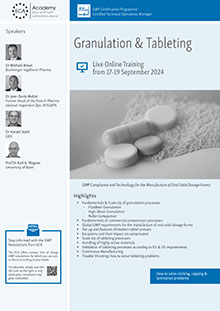FDA opens Docket on Continuous Manufacturing

Recommendation
17-19 September 2024
GMP Compliance and Technology for the Manufacture of Oral Solid Dosage Forms
In June 2017, the FDA opened a docket intended for public comments on the topic of continuous manufacturing. A docket is the central system of the U.S. authorities to obtain feedback on new laws, regulations and guidelines. Every comment disclosed there is publicly available. In this special case, the FDA's main interest concerns the document published by the C-SOPS working group. This document contains definitions and recommendations on continuous manufacturing. It was already published in 2016, but nearly missed in Europe. C-SOPS is short for Center for Structured Organic Particulate Systems. It was founded by a working group of university and industry representatives and is headquartered at Rutgers University.
Up to now, the document is rather a collection of definitions and explanations than a guideline, but it is certainly worth reading. It deals with the production of solid dosage forms (OSD). It explains control strategies for the process as well as the topics of steady state, state of control and mean residence time. These terms play a key role in continuous processes. In addition, it demonstrates the major differences between discontinuous and continuous production and also treats the important issue of batch definition in continuous processes. The number of possible batch definitions in continuous processes is even bigger than in conventional batch production. For instance, a batch can be:
- An amount of material brought in the process between time A and time B
- An amount yielded between time A and time B
- An absolute amount
- An amount produced between two process events (e.g. two pre-defined process conditions)
- An amount of product manufactured from a certain amount of starting material and further possibilities
During the release of continuously manufactured products, acceptance criteria such as compliance with CQAs (critical quality attributes) play the same role as in conventional production. It is crucial to ensure batch homogeneity here. It is pointed out that with continuous processes, not only is it possible to sample the final product, but there are many more ways to verify homogeneity and content uniformity, e.g. by analysing data from in-process monitoring and by using spectroscopic methods.
According to the document, it should further be possible to use different sampling methods depending on process knowledge. This is in accordance with the FDA multi-stage validation procedure which reflects that process knowledge increases over time: stage 1 (process design), stage 2 (process qualification) and stage 3 (continued process verification). In continuous processes, real-time-release will become tangible through the use of PAT. It is pointed out that not all IPCs must be part of a real-time-release.
Regulatory and approval issues are addressed as well. The procedures for IND and NDA submissions for instance are briefly discussed. Regarding the latter, the requirements for batch and continuous processes are the same. Post-approval changes are also discussed. Because it is assumed that continuous processes were developed based on the principles of QbD and on those of ICH Q8 (R2), Q9 and Q10, changes should be fairly easy. In further chapters, the topic of changing from a batch to a continuous process is addressed, both for approved products and for those still in the development phase.
Apart from comments on the C-SOPS document described above, the FDA is generally interested in comments and input on the issue of continuous manufacturing.
Please also see the FDA docket "Submission of Proposed Recommendations for Industry on Developing Continuous Manufacturing of Solid Dosage Drug Products in Pharmaceutical Manufacturing".
Related GMP News
GMP Conferences by Topics
- General Quality Assurance and GMP Compliance Topics
- Hygiene
- General Microbiology Topics
- Regulatory Affairs
- Development
- General Analytics Topics
- Good Distribution Practice
- Sterile Manufacturing
- Computer Validation
- General Qualification/Validation Topics
- General Engineering Topics
- APIs/Excipients
- GMP Basic Training Courses
- Medical Devices and Combination Products
- Packaging and Packaging Material
- Data Integrity
- Qualified Person (QP)
- GMP Auditing
- Documentation
- Cleaning Validation
- General IT Compliance Topics
- Impurities
- OOS / OOE / OOT
- Material Testing
- Validation of Analytical Methods
- Analytical Instrument Qualification
- Stability Testing
- Microbiological Testing
- Technology
- General Manufacturing Topics
- Solid Dosage Forms/Semi-Solid Dosage Forms
- Biotechnology/Blood/ATMP
- Herbal Drug Products/Cannabis/Radiopharmaceuticals
- Others




